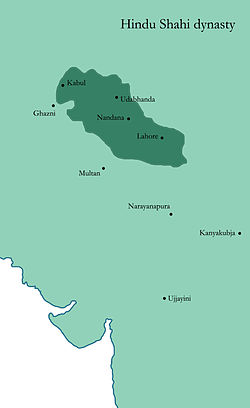Shalatura
| Author:Laxman Burdak, IFS (Retd.) |

Shalatura (शलातुर) is believed to have been birth place of Panini in Gandhara province of Pakistan/Afghanistan. Alexander Cunningham[1] has identified Salatura with village Lahor/Lavor, situated four miles to the north-east of Ohind.
Variants
- Shalatura शलातुर (AS, p.892)
- Shalatura शालातुर = शलातुर (AS, p.895)
- Salatura सलातुर = shalatura शलातुर (AS, p.944)
- Lahura लाहुर (AS, p.817)
- Salatura
- Sálátura
- Śalātura)
- Shalatur
- So-lo-tu-lo (सोलोतूलू) (by Xuanzang)
Location
Salatura, present Lahor (Swabi District in Khyber-Pakhtunkhwa, Pakistan) is situated four miles to the north-east of Ohind. The town is located at 34°02′54″N 72°21′56″E and lies west of Swabi and on the northern bank of the Indus River. Lahor is surrounded by Yar Hussain, Tordher, Ambar and the Indus.
Mention by Panini
Shalatura (शलातुर), Panini’s birth place, is mentioned by Panini in Ashtadhyayi. [2]
Shalaturiya (शालातुरीय) is mentioned by Panini in Ashtadhyayi. [3]
V S Agarwal[4] mentions.... Shalatura (शलातूर) (IV.3.94), modem Lahur situated at a distance of four miles from Ohind on the right bank of the Indus, in the northern angle of the junction of the Kabul river, identified as the birthplace of Panini.
History
Based on the Mahābhāṣya, it is believed that Śālātura was the birthplace of Pāṇini. In the Ashtadhyayi also, the place Śalātura is mentioned.[5]
According to Xuanzang (Hieun-Tsang), a statue of him existed at Śalātura, the place of his birth.[6]
Some writers identify Śalātura with the Shalatur village near Taxila in what is now the Punjab province of Pakistan.[7]
Alexander Cunningham[8] has identified Salatura with village Lahor/Lavor, situated four miles to the north-east of Ohind.
Visit by Xuanzang in 630 AD
Alexander Cunningham[9] writes about Salatura, or Lahor: Hwen Thsang next visited So-lo-tu-lo, or Salatura, the birthplace of the celebrated grammarian Panini, which he says was 20 li, or 3⅓ miles, to the north-west of Ohind. In January, 1848, during a day's halt at the village of Lahor, which is exactly four miles to the north-east of Ohind, I procured several Greek and Indo-Scythian coins, from which it may be
[p.58]: inferred, with some certainty, that the place is at least as old as the time of Panini himself, or about B.C. 350. I have, therefore, no hesitation in identifying Salatura with Lahor. The loss of the first syllable of the name is satisfactorily accounted for by the change of the palatal sibilant to the aspirate, according to the well-known usage of the people of western India, by whom the Sindhu river was called Hendhu and Indus, and the people on its banks Hindus or Indians ; Salatura would, therefore, have become Halatura and Alalur, which might easily have been corrupted to Lahor; or, as General Court writes the name, to Lavor.
शलातुर
शलातुर (AS, p.892): शलातुर प्राचीन उद्भांड या वर्तमान ओहिन्द (पाकिस्तान) से छ:-सात मील उत्तर-पश्चिम की ओर बसा हुआ ग्राम है जिसे संस्कृत के वैयाकरण पाणिनि का जन्म स्थान माना जाता है जो अब लाहुर कहलाता है. पाणिनि का जन्म सातवीं शती या 8वीं शती ईसा पूर्व में हुआ था. इनकी माता का नाम दक्षी था. सिंध नदी ओहिन्द के निकट बहती है. प्रसिद्ध चीनी यात्री युवानच्वांग ने 630 ई. के आसपास इस नगर को देखा था. उसने इसे सोलोतूलू लिखा है. युवानच्वांग ने शलातुर के निकट भीमादेवी का मंदिर देखा था जो शिव-मंदिर के निकट था. यहां भस्म रामाने वाले तीर्थक नामक साधुओं का निवास था. [10]
लाहुर
लाहुर (AS, p.817): लाहुर एक ऐतिहासिक स्थान है. लाहुर शलातुर का अपभ्रंश है। यह ग्राम संस्कृत के वैयाकरणाचार्य पाणिनि की जन्म भूमि माना जाता है। इसे 'लहोर' भी कहा जाता है. यह अटक और ओहिन्द (पश्चिमी पाकिस्तान) के निकट स्थित है। (दे. शलातुर, लहोर)
लहोर, जिला अटक, पाकिस्तान
लहोर (AS, p.814): लहोर अटक पाकिस्तान के निकट एक छोटा-सा ग्राम है. यह स्थान संस्कृत के प्रसिद्ध वैयाकरणाचार्य पाणिनि का जन्म स्थान शलातुर है। 'लहोर' या 'लाहुर' शलातुर का अपभ्रंश जान पड़ता है। [11]
External links
References
- ↑ The Ancient Geography of India/Gandhara, p. 57-58
- ↑ V. S. Agrawala: India as Known to Panini, 1953, p.9, 70
- ↑ V. S. Agrawala: India as Known to Panini, 1953, p.8, 9
- ↑ V S Agarwal: India as Known to Panini, p.70, sn.5.
- ↑ Giridhar Mishra: Deliberation on non-Paninian usages in the Adhyatma Ramayana, Sampurnanand Sanskrit University, Varanasi, India,1981
- ↑ Singh, Nagendra Kr.: Encyclopaedia of Hinduism, pp:1983–2007, isbn = 978-81-7488-168-7, 1997, Centre for International Religious, Anmol Publications, New Delhi
- ↑ Evolution of educational thought in India, Bhanwar Lal Dwivedi, Northern Book Centre, 1994, isbn=9788172110598, p.56
- ↑ The Ancient Geography of India/Gandhara, p. 57-58
- ↑ The Ancient Geography of India/Gandhara, p. 57-58
- ↑ Aitihasik Sthanavali by Vijayendra Kumar Mathur, p.892
- ↑ Aitihasik Sthanavali by Vijayendra Kumar Mathur, p.814
Back to Places

